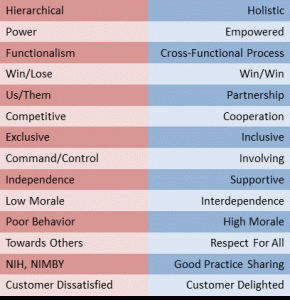Your Supply Chain can be a competitive weapon? ABSOLUTELY!!! However, the fundamental principles that guide the creation and management of supplier relationships must change!
If your organization continues to look at your supply chain as nothing but a supply base from which you must extract the annual pound of flesh of a few percentage points, you are probably conceding a tremendous competitive advantage to your competitors. Why? Because your suppliers are probably working with your competitors to help them gain a competitive advantage. The choice is simple for you as a supply chain/strategic sourcing professional. You can either lead your organization to extract significant value from your supply chain and convert it to a competitive advantage, or you can continue to focus on getting the best contracts and SLA’s while your competitors are stealing your lunch.
Twenty-five years ago Professor William Ouichi of the University of California did not have suppliers in mind when he proposed that American companies could meet the Japanese challenge. He believed they could do this by changing their organizations faulty assumptions about management and the workforce that had led to sub-optimal productivity. The relevant point here for us is that the assumptions we make about people drive our behavior towards them. You could even refer to this as a self-fulfilling prophecy.
Professor Ouichi revolutionized organizational theory by proposing Theory Z, a theory that workers were motivated by long-term employment, collective decision making, individual responsibility, evaluation and promotion, and the feeling that the company had holistic concern for them as an employee. We will similarly offer up our version of Theory Z but in a totally different context.
As both practitioners and consultants, we have observed significant sub-optimization in the value created by supplier relationships. Fundamentally, buyers and sellers have entered into relationships with a predetermined set of assumptions and these assumptions drive the wrong behavior on both sides. When relationships begin and are managed in such an antagonistic manner, value is lost. We believe that most sourcing/supply chain professionals have the wrong end point in mind and therefore end up leaving a significant amount of unrealized value on the table. When the end point is the best contract supported by well-defined SLAs, the behavior from both sides is defined and constrained by the contract.
The contract should be nothing but a step along the way to establishing mutual value creating relationships where both parties are focused on generating a significant amount of value for each other. Some of the best value-creating activities occur after the contract is signed by starting with a focus on a “Mutuality of Interest.” Both sides, the supplier and buyer organizations, need to be cognizant of this “Mutuality of Interest” so that the benefits are realized from the beginning and throughout the relationship.
The most mature organizations have seen the benefits of this approach to Strategic Sourcing. There is a proactive push and fundamental change being made to foster development of the skills necessary to manage the activities essential to capturing the promised “mutual” benefits and to identify additional “mutual” benefits of a partnership between supplier and buyer organizations. That is quite a fundamental shift and it requires a new set of attributes:
The shift requires a new set of skills, behaviors and competencies. Is your organization making the shift?
Regards,
Dalip


4 Comments
Pingback: News You Can Use | What Do You Mean I Should Worry About My Suppliers?
Pingback: Did you send that RFP to the Government? And why Santa may be late. - News You Can Use
Pingback: Financial Cost of Bad Trading Relationships - News You Can Use
Pingback: Expense/Cost Management – Brave New World or Back to the Future? - News You Can Use